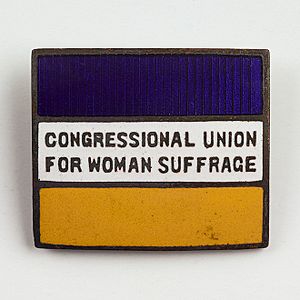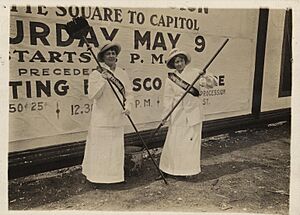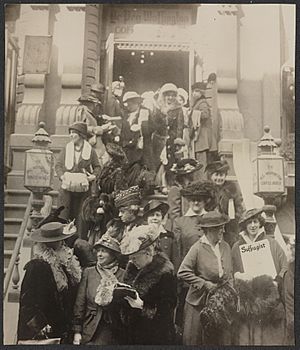Congressional Union for Woman Suffrage facts for kids

Congressional Union for Woman Suffrage pin, c. 1914–1917
|
|
| Abbreviation | CU or CUWS |
|---|---|
| Formation | April 1913 |
| Dissolved | 1916 |
| Type | NGO |
| Purpose | "To secure an amendment to the United States Constitution enfranchising women" and to pass the ERA |
| Headquarters | Washington, DC |
|
Key people
|
Alice Paul, Lucy Burns |
|
Formerly called
|
National American Woman Suffrage Association Congressional Committee |
The Congressional Union for Woman Suffrage was an American group started in 1913. It was led by Alice Paul and Lucy Burns. Their main goal was to get a change, called an amendment, added to the United States Constitution. This amendment would give all women the right to vote.
Alice Paul and Lucy Burns were inspired by the suffragette movement in the United Kingdom. They had even been part of it themselves. The Congressional Union's constant work helped bring attention to the idea of women voting. In 1914, they successfully got the amendment discussed in Congress for the first time in many years.
Contents
How the Congressional Union Started
Alice Paul first created the Congressional Union (CU) after joining the National American Woman Suffrage Association (NAWSA). She became a leader of NAWSA's Congressional Committee. The CU was formed to help this committee. Its leaders were also part of the committee.
The CU and NAWSA both wanted the same thing: a constitutional amendment giving women the right to vote. At first, the CU worked with NAWSA to make the Congressional Committee stronger. In March 1913, the CU began to manage its own activities and money. However, it still worked closely with NAWSA.
Later in 1913, the two groups started to disagree on how to achieve their goals. NAWSA's leaders felt that the CU's methods were too different. In December 1913, NAWSA chose a new Congressional Committee. They officially ended their connection with the Congressional Union.
New Ways to Fight for Rights
The Congressional Union for Woman Suffrage attracted many young women. They offered a fresh approach to the fight for women's voting rights. This new way was inspired by the British suffragettes.
Alice Paul believed women should not have to beg for their rights. She brought some of the strong methods used by the Women's Social and Political Union in Britain to the CU. These methods included direct actions, organizing huge protests, and daily picketing outside the White House. By 1914, the CU had 4,500 members. They had also raised over $50,000 to support their work. Many members were arrested and sometimes jailed for their efforts.
How the Organization Worked
The Congressional Union's main office was in Washington, D.C. It was on F Street, close to the Willard Hotel. They paid for this highly visible office themselves. They also started "suffrage schools" for women. These schools helped spread awareness about their cause. They held many meetings every day.
The CU did not organize itself by states or districts. However, there were different branches of the group in several states. The Washington headquarters was key to their work. But they also moved around a lot to reach more people. The CU published a newspaper called The Suffragist. It featured articles by important members like Alice Paul, Lucy Burns, and Inez Milholland. The newspaper hired Nina Allender as its main cartoonist. It also published cartoons by artists such as Cornelia Barns and Boardman Robinson.
Campaigning for the Vote
The Congressional Union actively campaigned for a constitutional amendment. This amendment would guarantee all women the right to vote. They used methods similar to those of the British suffragettes. The CU blamed the main political party for not moving the Federal Suffrage Amendment forward. At that time, the Democratic Party was the main party. Democrat Woodrow Wilson was the president.
CU members traveled to western states. They campaigned against Democrats there. They hoped this would stop Democrats from being re-elected. They even campaigned against Democrats who supported women's suffrage. This caused criticism from the National American Woman Suffrage Association. The CU members traveled across the west by train. They used different ways to get noticed. Their speeches at train stops attracted reporters. Their campaign led to 20 Democrats who supported suffrage losing their elections. This upset NAWSA greatly.
The National Woman's Party
The Congressional Union created the National Woman's Party in 1916. This happened at a meeting in Chicago. The new party included members from the Congressional Union. Alice Paul was in charge of the party. A Campaign Committee was formed within the party. Anne Martin was its chairman.
In 1917, the two organizations officially joined together. They formed the National Woman's Party (NWP). Alice Paul was elected as their chairman. After the 19th Amendment was approved, the National Woman's Party started a long campaign. Their new goal was to get the Equal Rights Amendment passed.
Continuing the Fight for Equal Rights
In 1981, a group of women formed an organization called the Congressional Union. This group included Mary Ann Beall and well-known feminist Sonia Johnson. They started in New York City. Their goal was to keep fighting for the Equal Rights Amendment (ERA).
Sonia Johnson wrote in her book that they were inspired by the suffragists. She said, "...we called ourselves the Congressional Union, taking the name and philosophy from the women's suffrage group created in 1914 by Alice Paul and Lucy Burns..." In June 1982, this Congressional Union held a "ritual of mourning" and a "celebration of rebirth" for the ERA. This event took place at the National Archives.
Later, this organization split. A group of women, including Johnson, formed a new feminist group. It was known as A Group of Women."
Important Members
- Abby Scott Baker
- Alice Paul
- Belle Case La Follette
- Caroline E. Spencer
- Crystal Eastman
- Dora Lewis
- Doris Stevens
- Dorothy Day
- Helen Keller
- Mabel Vernon
- Mary Beard
- Lawrence Lewis
- Lucy G. Branham
- Lucy Burns
- Mary A. Nolan
- Mary Hunter Austin
- Mary Ritter Beard
- Maria Montessori
- Matilda Young
- Nina Samarodin
- Olympia Brown
- Rose Winslow
- Sue Sheldon White
See also
- List of suffragists and suffragettes
- Timeline of women's suffrage
- Women's suffrage organizations



